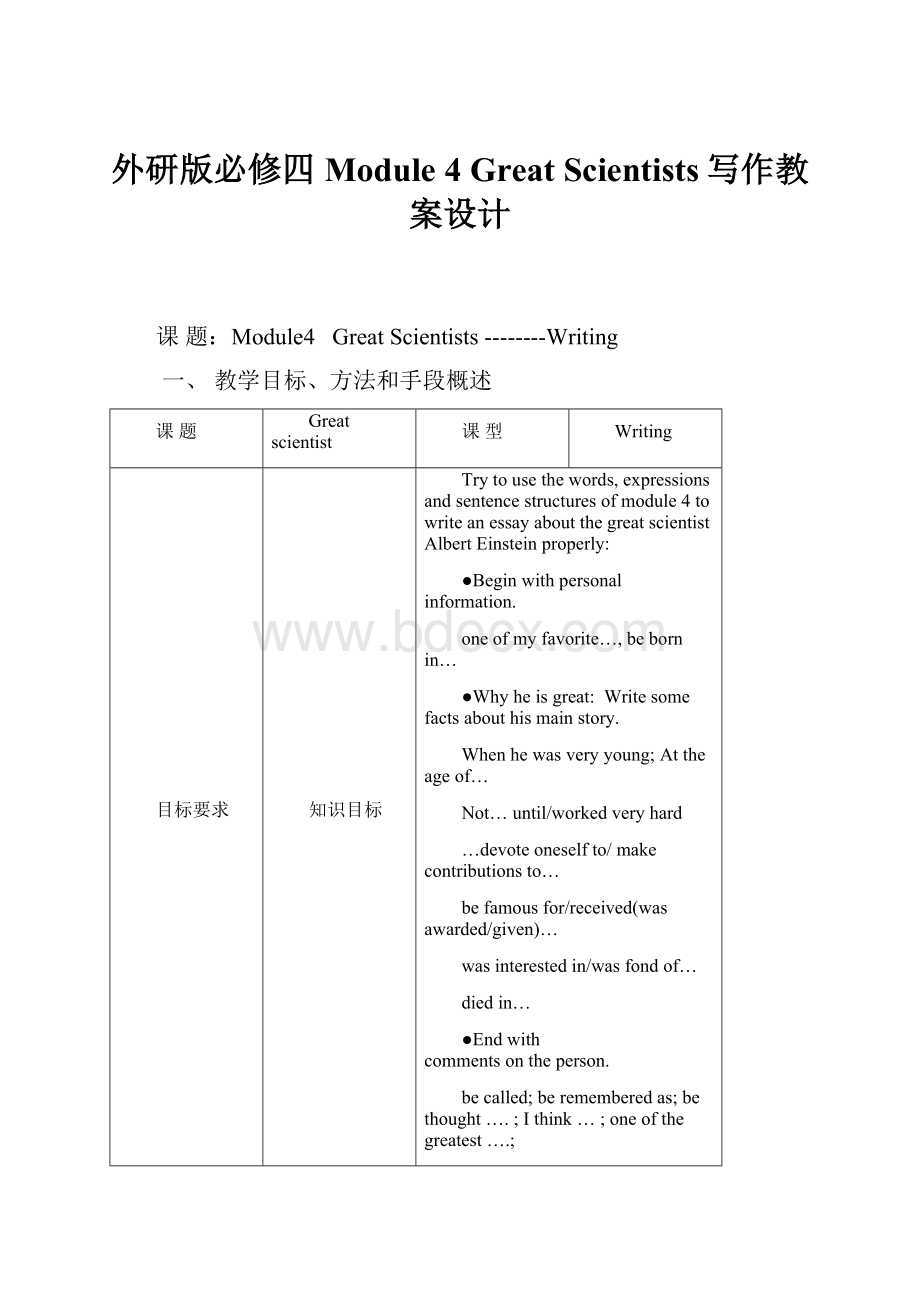外研版必修四Module 4 Great Scientists写作教案设计.docx
《外研版必修四Module 4 Great Scientists写作教案设计.docx》由会员分享,可在线阅读,更多相关《外研版必修四Module 4 Great Scientists写作教案设计.docx(17页珍藏版)》请在冰豆网上搜索。

外研版必修四Module4GreatScientists写作教案设计
课题:
Module4GreatScientists--------Writing
一、教学目标、方法和手段概述
课题
Greatscientist
课型
Writing
目标要求
知识目标
Trytousethewords,expressionsandsentencestructuresofmodule4towriteanessayaboutthegreatscientistAlbertEinsteinproperly:
●Beginwithpersonalinformation.
oneofmyfavorite…,bebornin…
●Why he isgreat:
Writesomefactsabouthismainstory.
Whenhewasveryyoung;Attheageof…
Not…until/workedveryhard
…devoteoneselfto/makecontributionsto…
befamousfor/received(wasawarded/given)…
wasinterestedin/wasfondof…
diedin…
●Endwithcomments on the person.
becalled;berememberedas;bethought….;Ithink…;oneofthegreatest….;
能力目标
1.Developagoodwritinghabit---reading,discussionandwriting.
2.Improvethestudents’abilitytolearnhowtowriteashortpassageaboutagreatscientistusingthenotes.
3.Encourageandhelpthestudentstomakesentencesmoreorganizedandmastertheskillsofwritingapassageaboutagreatscientist.
情感态度
价值观
1.Guidethestudentstolearntoworkcooperativelywithothers.
2.Helpthestudentslearnfromthegreatscientists,suchasthespiritofdevotingtoscience,seekingtruthandpersistentdedicationforhuman’shappinessanddevelopment.
教学重
难点
1.Helpthestudentslearnhowtoorganizetheirlanguageandwriteapassageaboutagreatscientist.
2.Howtoimprovethestudent’swritingskillsandencouragethestudentstoparticipateinclassactively.
教学方法
Task-basedteachingmethod;groupworkandindividualworktogeteverystudenttoparticipateinclass.
教学手段
多媒体;导学案
二、教学流程设计
Pre-writing
Step1.Revision&leading-in(3minutes)
(设计意图:
创设情境,复习导入。
以话题Guesswhoheis!
开展师生互动、生生互动活动,激活学生已有知识进行主题导入,为下面进一步调动学生尝试写作奠定良好的情感基础。
)
T:
Classbegins!
Ss:
Goodmorning,MissGao!
T:
Goodmorning,boysandgirls!
Sitdown,please!
Ss:
Thankyou!
T:
Inthepreviouslessons,wetalkedalotaboutgreatscientistsintheworld.Nowlistentomecarefullyandguesswhoheis.
Guesswhoheis!
HeisaChinesefamousscientist.
Hisachievementshavesomethingtodowithfarming.
Peoplewillalwaysrememberhimforwhathedid.
Heiscalledthefatherofhybridrice.
Ss:
YuanLongping
T:
Right!
Whocansaysomethingaboutanotherscientistandletusguess?
S1:
Listentomeandguess.
HeisafamousChinesephysicist.
HeoncestudiedintheUSAandthenreturnedtoChina.
Hemadegreatcontributionstospaceresearch.
HeisknownasthefatherofChina'smissile.
Ss:
QianXuesen.(学生齐声)
S2:
…
T:
Youhavedoneagoodjob!
Wehavelearnedalotaboutgreatscientists.Ifindyouareinterestedinscienceandscientists.Nowlet’sclearourlearningaims.(幻灯片展示目标,明确任务。
)Pleasereaditbyyourselves.
1.UsethenotestowriteashortpassageaboutthegreatscientistAlbertEinsteinwithabout100words.
2.Developagoodwritinghabit---reading,discussionandwriting.
3.Makesentencesmoreorganizedandmastertheskillsofwritingapassage.
T:
Doyouknowhowtowriteaboutagreatscientist?
Ss:
Silent.
T:
Itdoesn’tmatter.Inordertogetsomeusefulinformationforourwriting,let’sreadashortpassageonpage37andfindoutthewriter’swritingideas.
Step2.Reading:
(about142words;suggestedtime:
5minutes)
(设计意图:
利用课本中给的阅读材料,指导学生个别活动,阅读短文并回答问题;小组讨论(Workingroupsanddiscuss)学习并分析怎样描写人物传记:
抓住其出生年月、主要事迹、人们的评论等进行叙述。
掌握写人物传记的常用词汇和句型。
以问题的形式给学生具体的任务,同时也给学生独立思考的空间和合作交流的时间,任务链一环扣一环,引领学生理清写作思路,培养学生查找和获取有用信息的能力,为写作备料。
)
T:
Pleasereadtheshortpassageonpage37andfinishthetasksbyyourselvesonyourguidingpaperasquicklyasyoucan.
★Task1:
Vocabulary:
Matchthewordsintheboxwiththedefinitions.
best-sellercosmologydiagnosedisability
motorneuronediseasevictim
1.apersonwhohasbeenattacked,injuredorkilledasaresultofacrime,anaccident,etc.
2.todiscoverthecauseofanillnessoraproblem
3.abookthatsellsinverylargenumbers
4.thestudyoftheoriginanddevelopmentoftheuniverse
5.thestateofbeingdisabled
6.anillness
Answers:
1.victim2.diagnose3.best-seller4.cosmology5.disability6.motorneuronedisease
★Task2:
ReadthepassageaboutStephenHawkingandnumbertheparagraphsinthecorrectorder.(activity2onpage37.)
Answers:
2—3—1
★Task3:
Writethenumberoftheparagraph.(activity3onpage37.)
1.ThisparagraphexplainswhyHawkingisfamous.
2.ThisparagraphtalksaboutHawking’spersonallife.
3.ThisparagraphtalksaboutHawking’sscientificcareer.
Answers:
1)Paragraph1(thethirdinthebook)
2)Paragraph2(thefirstinthebook)
3)Paragraph3(thesecondinthebook)
★Task4:
Lookthroughthepassageagaintoanswerthefollowingquestions.
1).What’sthewritingstyle(体裁)?
2).What’sthemainverbtenses(时态)inthepassage?
Answers:
1)Itisnarration.(记叙文)
2)Thesimplepasttense.(一般过去时态)
Ss:
Readsilentlyanddothetasksontheirguidingpaperfor5minutes.
T:
(5minuteslater.)Haveyoufinished?
Ss:
Yes.(学生齐声)
T:
Good!
Youcandiscussandshareyouranswersinpairsfor2minutes.
T:
Let’slookatthereadingtaskstogether.Who’dliketoshareyourinformationaboutvocabulary?
S1:
1.victim2.diagnose3.best-seller4.cosmology5.disability6.motorneuronedisease
T:
Goodunderstanding!
(展示幻灯片)Let’slookatthestructureofthepassagetogether.Whatisthecorrectorder?
S2:
2—3—1
T:
Verygoodunderstanding!
Whatabouttask3?
Who’dliketoshareyourinformationwithus?
S3:
1)Paragraph1(thethirdinthebook);2)Paragraph2(thefirstinthebook);3)Paragraph3(thesecondinthebook).
T:
Verygoodsentence!
Youarequiteright!
Who’dliketoshareyourinformationabouttask4?
S4:
这是一篇记叙文,主要时态是一般过去时态。
ButIdon’tknowhowtosayinEngliash.
T:
Itdoes’tmatter.Thankyouforyourgoodunderstandingandcorrectanalysis.Youarequiteright!
InEnglishitisanarration.(记叙文)。
Thesimplepasttense(一般过去时态)ismainlyusedinthispassage.
(板书:
narration记叙文;thesimplepasttense一般过去时态。
)
T:
Sincewehavereadandanalyzedtheshortpassage,wehavegotthetenses(时态)andsomedetailedinformationaboutStephenHawking.Nowit’stimeforustothinkabouthowtowriteanessayaboutthegreatscientistAlbertEinstein.(展示幻灯片)
WritingTask:
根据汉语提示,以ASimpleManofGreatAchievement为题写一篇介绍爱因斯坦的短文。
姓名:
爱因斯坦 出生年月:
1879.3.14 出生地:
德国
学历:
14岁前自学数学,17岁开始在瑞士学习,1905年获博士学位
工作简历:
1905~1915进行他在物理学方面获得新发现的研究工作;1921年获诺贝尔奖,此外,还为人权和人类进步而工作
性格业余爱好:
喜欢音乐,生活简朴,对金钱和名誉不感兴趣
注意:
1.不要逐字翻译;2.字数100左右;3.标题已给,不计入总数。
I’dliketodivideyouintosmallgroupsanddiscussthefollowingquestions.5minutesallowed.
(板书:
1.Howcanwewritethebeginningofthepassage?
2.WhyisAlbertEinsteingreat?
3.Whatisyouropinion?
)
Step3.Discussandorganizetheinformation(13minutes)
(设计意图:
采用分组讨论问题Howtowriteaboutabiographyofafamousperson?
引发学生自主探究、合作交流的教学方式,激发学生的写作动机与积极性,帮助学生激活与写作任务有关的知识网络,点拨学生选择与整理素材,发现并掌握写作所需要的有用表达,为下文谋词成句、连句成篇和进一步高质量地完成写作任务做好充分的准备。
)
T:
Discussingroupsandorganizetheinformation.
1.Howcanwewritethebeginningofthepassage?
2.WhyisAlbertEinsteingreat?
3.Whatisyouropinion?
Ss:
Discussingroupsandorganizetheinformationontheirguidingpaperfor5minutes.
(Ss讨论时T在教室走动,密切关注各个小组的讨论进程,适时提供帮助并提醒学生在讨论中尽量使用英语交流。
帮助平时不善言谈的学生和基础较差的学生开口交流。
)
T:
Expressasmanyideasonthetopicasyoucan.Shareyouranswerswitheachother.(5minuteslater,collecttheinformationSshavefoundandexchanged.)
T:
OK,timeisup.Iheardyouractivewords,veryexcellent!
Let’sshareyourinformation.Howcanwewritethebeginningofthepassage?
S1:
AlbertEinsteinwasprobablythemostbrilliantscientistofthetwentiethcentury.
T:
Averygoodstart!
Anyotherintroductions?
S2:
AlbertEinsteinwasmyfavoritegreatscientist.HewasborninGermanyonMarch14,1879andwasagreatscientistwithanextraordinaryimagination.Goodidea!
T:
Goodidea!
Verybeautifulsentences!
Howcanwechangethesentencesaboveusingmodifiers(修饰语)?
例如可以巧用with结构做定语。
S3:
BorninGermany,AlbertEinsteinwasagreatscientistwithanextraordinaryimagination.
T:
Excellent!
(板书:
BorninGermany,AlbertEinsteinwasagreatscientistwithanextraordinaryimagination.)Whocantranslatehissentence?
S4:
爱因斯坦出生在德国,是一位有着非凡想象力的伟大科学家。
T:
Goodtranslation!
Iagreewithyouverymuch.WhyisAlbertEinsteingreat?
S5:
Beforehewas14yearsold,hehadlearnedmath.
T:
Quiteright!
Wecanalsosay:
By14yearsold,hehadlearnedadvancedmathallbyhimself.(板书:
By14yearsold,hehadlearnedadvancedmathallbyhimself.)Isthereanyothergoodideas?
S6:
Whenhewas17yearsold,hewenttoSwitzerlandandstudiedthere.
T:
Youmadeaverygoodsentence!
Later,thegreatmanAlbertEinsteinstudiedinSwitzerland.(板书:
When…wentto…andstudied…)
Anythingelse?
S7:
爱因斯坦在1905年获得博士学位并且开始进行他在物理学方面获得新发现的研究工作。
ButIdon’tknowhowtosay.
T:
Itdoesn’tmatter.Youhaveaverygoodidea!
Youaresoactive!
Don’tbeafraidtomakemistakes.WhocanhelphiminEnglish?
Howcanwetranslatehissentence?
S8:
In1905,hereceivedadoctor'sdegree.Atthesametime,hebeganhisresearchandthathelpedhimmakeanewdiscovery.
T:
Soundsgreatandgoodtranslation!
Pleasethinkitover.Howcanwetranslatethissentenceusinganattributiveclause?
Ithinkyoucanmakethissentence.Beactive,boysandgirls!
Haveatry,please!
S9:
In1905,hereceivedadoctor'sdegreeandbeganhisresearchwhichledtoanewdiscovery.
T:
Excellenttranslation!
(板书:
receivedadoctor'sdegreeandbegan…whichledto…)Isthereanyothergoodideas?
S10:
In1921,hewontheNobelPrizeforphysics.
T:
Quiteright!
Abeautifulsentence!
(板书:
wontheNobelPrizefor…)Anyothergoodideas?
S11:
Henotonlyworkedhardinphysics,butalso